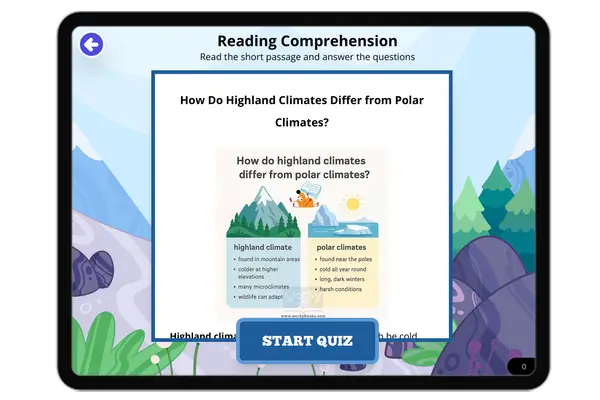Humid Continental Climate Characteristics — Passage
A humid continental climate is a type of temperate climate found in parts of North America, Europe, and Asia, especially in areas that are far from the ocean. This climate has hot summers, cold winters, and a wide range of temperatures throughout the year. It also gets moderate to high rainfall, which supports many types of plants and forests.
One of the most important features of this climate is that it has four distinct seasons—spring, summer, autumn, and winter. Summers can be warm or hot and often have thunderstorms. Winters can be very cold, with snow and freezing temperatures. Because the land is far from large bodies of water, there is nothing to keep the temperature steady, so it changes a lot with the seasons.
The humid continental climate is divided into two main types:
● Warm summer subtype: Summers are hot and humid, winters are cold and snowy (example: New York City or Beijing).
● Cool summer subtype: Summers are mild, and winters are very cold (example: Moscow or parts of Canada).
This climate is great for growing crops like wheat, corn, and apples, thanks to its warm summers and good rainfall. It also supports many deciduous forests, which are trees that lose their leaves in the fall.
People living in this climate need different clothes and homes for each season—like air conditioning in summer and heating in winter.
Fun Fact: The humid continental climate is one of the only climates that regularly experiences both snowstorms and heatwaves in the same year!
Where is the humid continental climate found?
Near the equatorOn islands in the oceanIn areas far from the ocean, like North America and AsiaOnly in tropical rainforestsHow many seasons does a humid continental climate have?
TwoFourOneSixWhat are winters like in a humid continental climate?
Hot and dryCold and snowyMild with no snowWarm and rainyWhy does the temperature change so much in this climate?
The wind blows all yearIt is close to the oceanThe land is far from water that would keep it steadyThere are too many treesWhat types of crops grow well in this climate?
Bananas and coconutsCorn, wheat, and applesPineapples and riceCoffee and sugarcaneWhat is the difference between the warm summer and cool summer subtypes?
One gets more sunshineOne has deserts and one does notOne has hotter summers than the otherOne has fewer animalsWhat is the main idea of the passage?
Humid continental climates never changeThis climate only exists in EuropeThe humid continental climate has four seasons and big temperature changesPeople don’t live in this climateWhy do people in this climate need different clothes and homes for each season?
Because they move every monthThe weather is always the sameThe seasons are shortThe temperatures are very different in summer and winter








